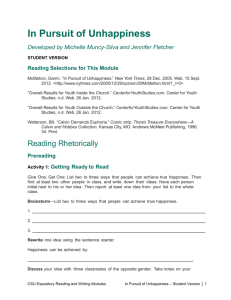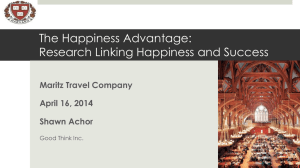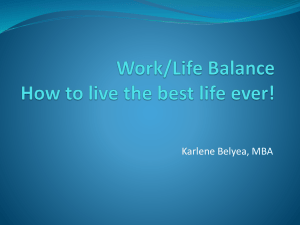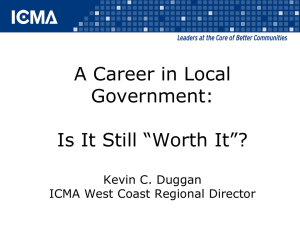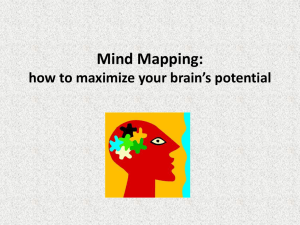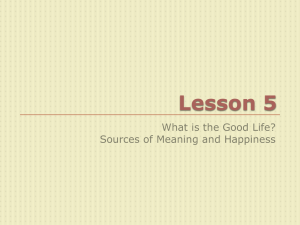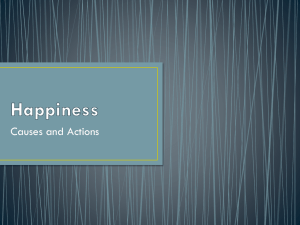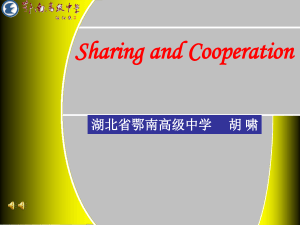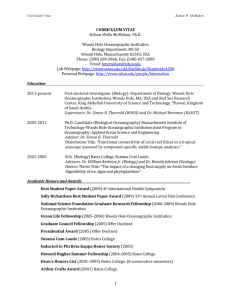ERWC: LEOPARD MAN - The Byron Broadcast
advertisement
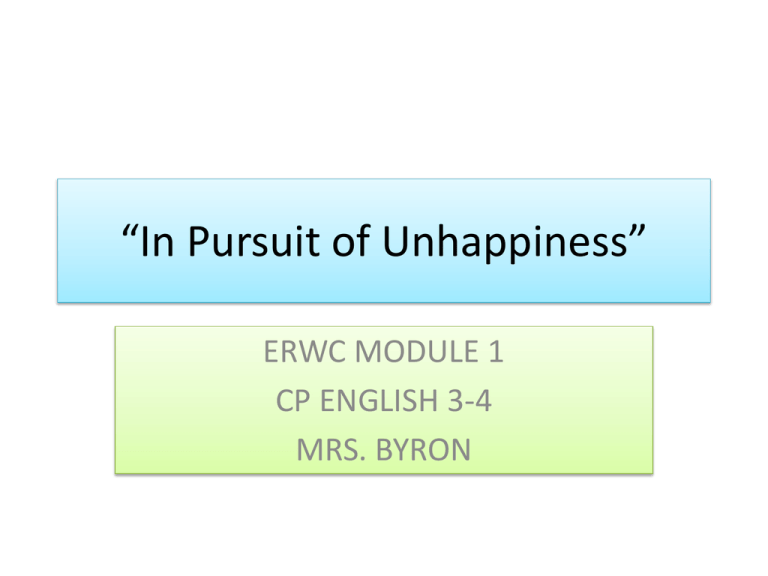
“In Pursuit of Unhappiness” ERWC MODULE 1 CP ENGLISH 3-4 MRS. BYRON ERWC: MODULE 1 IN PURSUIT OF UNHAPPINES PRE-READING ACTIVITY 1: GETTING READY TO READ In your Writer’s Notebook: • Brainstorm—list 2-3 ways people can achieve true happiness • Rewrite on idea using the sentence starter: • Happiness can be achieved by ________________ _______________________________. ACTIVITY 1 CONTINUED GIVE ONE, GET ONE • Discuss your idea with three classmates. Take notes on what they say and put their initials next to their idea. • Report one idea that you heard to the whole class. – ________________ pointed out that…. – ________________ shared that… ACTIVITY 2: QUICKWRITE DIRECTIONS: After hearing from the class about what other students think will create happiness, take a look at the following graph, in which a total of 66 youth rated what they believe makes or would make them happy. After considering the graph, agree or disagree with the statement that people can force their own happiness. ACTIVITY 2: QUICKWRITE ACTIVITY 3: SURVEYING THE TEXT 1. What does the title, “In Pursuit of Unhappiness” tell you about McMahon’s position on what makes a person happy? 2. What do you think is the article’s purpose? ACTIVITY 4: MAKING PREDICTIONS DIRECTIONS: Read each section of text in the following slides. Before you move on to the next quote, answer these questions: 1. What do you notice? 2. What words and ideas seem to be important? 3. What do you predict the next section will be about? ACTIVITY 4: QUOTATION 1 “HAPPY New Year! We seldom think of those word as an order. But in some respects that is what they are.” ACTIVITY 4: QUOTATION 2 “Doesn’t every American want to be happy? And don’t most Americans yearn deep down to be happy all the time?” ACTIVITY 4: QUOTATION 3 “The right laid out in our nation’s Declaration of Independence—to pursue happiness to our heart’s content—is nowhere on better display than in the rites of the holiday season. With glad tidings and good cheer, we seek to bring one year to its natural, happy conclusion, while preparing to usher in a happy new year and many happy returns.” ACTIVITY 4: QUOTATION 4 “So in these last days of 2005 I say to you, ‘Don’t have a happy new year!’…If you’re so inclined, put in some good hours at the office or at your favorite charity, temple or church…With luck, you’ll find happiness by the by. If not, your time won’t be wasted. You may even bring a little joy to the world.” ACTIVITY 5: ASKING QUESTIONS Use complete sentences to respond in your Writer’s Notebook: 1. What do you think McMahon will have to say about the American goal to be happy? 2. Why do you think the author spent so many lines introducing the American goal of happiness and then titled the piece, “In Pursuit of Unhappiness”? ACTIVITY 6: SOAPSTone What the heck is SOAPSTone? Relate SOAPSTone to the article S SUBJECT—general topic, content, and ideas contained in the text. The “Pursuit of Unhappiness” is about… O OCCASION—the time and place of the piece, the current situation. The events that led up to the writing of this piece include… A AUDIENCE—The group of readers to whom this piece is addressed. From the words _______ and _______, it can be assumed that the intended audience is… P PURPOSE—the author’s reason behind the text. The main purpose of the article is to… S From the words _______ and _______, SPEAKER—the author’s voice and persona used to tell the story (or make a it can be assumed that the author is… point). TONE The emotional attitude a writer expresses toward the subject. Describe the writer’s “voice” For example, voice can be sarcastic, humble, bitter, or reverent. In the introductory paragraphs, the author’s attitude is one of… (Consider the repetition of the words “happy”) ERWC: MODULE 1 IN PURSUIT OF UNHAPPINESS READING ACTIVITY 8: FIRST READING • Read “In Pursuit of Unhappiness” as a class. • As you read, think about the predictions you made (Activities 4-6). 1. How accurate were your prediction? 2. When you read the whole article what (if anything) surprised you? 3. What parts of the article did you find confusing? Mark the paragraph(s). ACTIVITY 9: LOOKING CLOSELY AT LANGUAGE • • • • • • • Contentment Pleasure Euphoria Joy happiness Bliss Satisfaction Rank these words on a scale of 1-6, with 6 being the state of greatest happiness. ACTIVITY 10: CONNOTATION WORD YEARN UNADULTERATED BLISS STAGNANCY STEEPED RELENTLESS PREOCCUPATION DENOTATION CONNOTATION ACTIVITY 11: ANALYZING STYLE WORDS 1. What does paradox mean to you? 2. What synonyms for happy does the author use in the essay? 3. What synonyms for unhappy does the author use in this essay? 4. Does the author make more mention of happiness or unhappiness in the essay? Why do you think so? ACTIVITY 11: ANALYZING STYLE SENTENCES The author makes a handful of statements that are surprising. The title “In Pursuit of Unhappiness” is an example of that. 1. Why does the author us this contradictory statement as his title? 2. What is the effect on the reader of that contradition? ACTIVITY 11: ANALYZING STYLE PARAGRAPH 1. Why did the author choose to write the first word all in caps? And how many times is the word repeated throughout the introduction? What is the effect of that repetition? 2. Why did the author choose to open the second paragraph with two rhetorical questions? 3. What is McMahon trying to do in writing this way? ERWC: MODULE 1 In Pursuit of Unhappiness POSTREADING ACTIVITY 13: SUMMARY & RESPONSE DIRECTIONS: Write a summary paragraph for “In Pursuit of Unhappiness” using key words from the article. • STEP ONE: Using actual words from the article, create a list of the five most important words from the article. • STEP TWO: Compare your five words to your partner’s. Create a new list of five most important words by synthesizing your two lists. Choose words that represent the author’s main idea. • STEP THREE: Compare you and your partner’s list to another pair’s list. Create a new list of the most important words from the article that represent the main idea of the article. The group must come to a consensus. • STEP FOUR: On your own, use the final list of five key words to write a summary paragraph for the article. ACTIVITY 14: THINKING CRITICALLY DIRECTIONS: Answer the following in your WN and be ready to discuss your ideas. (LOGOS Questions) 1. Why does McMahon us the example of the holiday season? 2. In the third paragraph, what assumption about happiness does the quotation from Thomas Carlyle challege? 3. According to McMahon’s paraphrase of Carlyle in the fourth paragraph, what caused the change in the concept of happiness? What is the historical discussion important to McMahon’s argument? 4. What assumptions does McMahon make about the cause and effect relationships between self-help books and the percentage of happy people? ACTIVITY 14: THINKING CRITICALLY DIRECTIONS: Answer the following in your WN and be ready to discuss your ideas. (ETHOS Questions) 1. What is McMahon’s profession? Does that make him more or less believable? 2. What do McMahon’s references to Thomas Carlyle and John Stuart Mill do for his own image and credibility? 3. What does McMahon make Carlyle’s views and personality such a prominent focus? To what extent does McMahon seems to agree with Carlyle? ACTIVITY 14: THINKING CRITICALLY DIRECTIONS: Answer the following in your WN and be ready to discuss your ideas. (PATHOS Questions) 1. 2. 3. What feelings do the opening paragraphs create in the reader? Is there a genuine sense of “glad tidings and good cheer” in the first two paragraphs or is something else going on? In paragraph nine, McMahon describes the “mysterious [holiday] blues that are apt to set in while the streamers stream and corks pop.” How does this paragraph intended to affect the reader? What kind of sadness does McMahon describe? In the final paragraph, McMahon describes several activities that he suggests are better ways of spending our time than trying to make ourselves happy, including having dinner with family, volunteering, or spending time with your child. What emotions do these examples create in the reader? ACTIVITY 16: USING THE WORDS OF OTHERS DIRECTIONS: This activity is designed to help you become aware of how McMahon uses language to talk about the words of others—using direct quotations, paraphrasing, or summarizing. Identify the source of the comment (who said it) and whether the remark is a direct quotation, paraphrase or summary. • Record this as part of your text annotation. ACTIVITY 16 (Mark Text) 1. 2. 3. 4. Paragraph 7: “Sociologists like to point out that the percentage of those describing themselves as ‘happy’ or ‘very happy’ has remained virtually unchanged.” Paragraph 3: “As Thomas Carlyle observed in 1843, ‘Happiness out being’s end and aim is at bottom, if we will count well, not yet two centuries old.” Paragraph 8: “…economists like Lord Richard Layard and Daniel Kahneman have argued that the apparent stagnancy of happiness in modern societies should prompt policymakers to shift their priorities from the creation of wealth to the creation of good feelings…” Paragraph 10: “ ‘Ask yourself whether you are happy, and you cease to be so,’ Mill concluded after recovering from a serious bout of depression.” ACTIVITY 17: ANNOTATE THE TEXT FIRST HIGHLIGHTING: Use a YELLOW highlighter to mark Thomas Carlyle’s quotations. Explain how these quotes support McMahon’s argument. SECOND HIGHLIGHTING: Use a PINK highlighter to mark John Stuart Mill’s quotes. Explain how these quotes support McMahon’s argument. ACTIVITY 18: QUICKWRITE Answer the following questions— In what ways are Thomas Carlyle and John Stuart Mills similar in their thinking about happiness? In what ways are they different? What facet of argument does Carlyle serve? What does Mills’ quote provide to McMahon’s argument? ACTIVITY 19: Rhetorical Précis Directions: • Write a rhetorical précis of the article. A précis is a concise summary of what you’ve read including both what the text says and what the text does rhetorically. In other words, a précis presents the what, how, why and who of a writer’s argument. • Please make use of the précis template provided. ACTIVITY 19: Rhetorical Précis TEMPLATE SENTENCE 1: Introduce the name of the author, the title of the work, and a rhetorically accurate verb that describes the intent of the author (“claims,” “argues,” “suggests); and a THAT clause containing the major assertion or controlling idea of the work. SENTENCE 2: Explain how the author supports or develops their argument. In other words, cite the kind of evidence or method the author uses to advance their claims rather than the details of the work. Sentence 3: State what you think the author’s purpose is including either in the beginning or at the end an “in order to” phrase. Sentence 4: Describe the intended audience and/or the relationship. Template Sentence One In his/her ________ (type of work), “______________” (title of work), _______________ (name of author) _______________ (a rhetorically accurate verb) that ________________________________ (the author’s assertion, argument, position, etc.). In her article "Who Cares if Johnny Can't Read?" (1997), Larissa MacFarquhar asserts that Americans are reading more than ever despite claims to the contrary and that it is time to reconsider why we value reading so much, especially certain kinds of "high culture" reading. Template Sentence #2 _______________ (author’s last name) develops/supports this ___________ (change the rhetorical verb to noun) by/with ____________(reveal author’s technique). MacFarquhar supports her assertion about American reading habits with facts and statistics that compare past and present reading practices, and she challenges common assumptions by raising questions about reading's intrinsic value. Template Sentence #3 __________’s (author) purpose is to ___________(reveal author’s purpose) in order to ________________(what author wants reading audience to react to, feel and/or do). Her purpose is to dispel certain myths about reading in order to raise new and more important questions about the value of reading and other media in our culture. Template Sentence #4 _________ (author) uses _________ (description of tone) with his/her _________ (describe author’s audience). Variation from template: She seems to have a young, hip, somewhat irreverent audience in mind because her tone is sarcastic, and she suggests that the ideas she opposes are old-fashioned positions. Follows template strictly: He establishes an informal relationship with his audience of college students who are interested in learning to write "with conviction" (55). #1. In his/her ________ (type of work), “______________” (title of work), _______________ (name of author) _______________ (a rhetorically accurate verb) that ________________________________ (the author’s assertion, argument, position, etc.). #2. _______________ (author’s last name) develops/supports this ___________ (change the rhetorical verb to noun) by/with ____________ (reveal author’s technique). #3. __________’s (author) purpose is to ___________ (reveal author’s purpose) in order to ________________ (what author wants reading audience to react to, feel, and/or do). #4. _________ (author) uses_________ (description of tone) with his/her _________ (describe author’s audience). ERWC: MODULE 1 “In Pursuit of Unhappiness” PREWRITING ACTIVITY 20: WRITING The writing task will require you to: 1. Paraphrase the writer’s (Mills) argument 2. Take a position on the writer’s conclusion to the argument 3. Construct your own argument in response: Agree, disagree, or somewhere in between, but be sure to support your position. ACTIVITY 21: GETTING READY TO WRITE 1. What specific question will your essay answer? What is your tentative response to the question? (working thesis) 2. Which views on creating happiness most closely mirror your own? 3. What support have you found for your thesis? 4. What evidence do you have for that support? 5. How much background information do your readers need to understand the topic of creating happiness? 6. If readers were to disagree with your thesis, what would they say? How could you address those concerns? Now draft your thesis. As you write, be open to the idea of possibly changing your thesis s your argument develops. ACTIVITY 22-26 • PROVIDE THESE ACTIVITIES TO STUDENTS USING COPIES OF THE “STUDENT VERSION”
